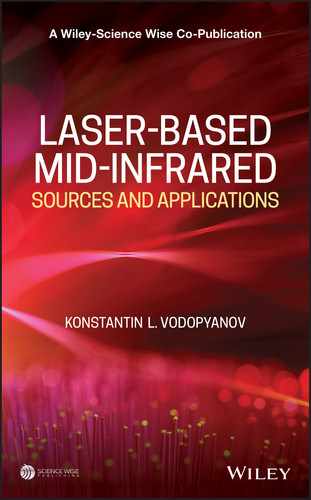Preface
The field of mid‐infrared (mid‐IR) photonics is rapidly expanding driven by a growing number of applications in fundamental science, technology, defense, medicine, biology, environmental monitoring, among others. The last 25 years have seen remarkable advances in the field of mid‐IR lasers starting with the quantum cascade laser pioneered by Lucent Technologies in 1994 and followed by a growing number of diverse innovative approaches to coherent light generation in this spectral range. Because the last comprehensive book on the subject, Solid‐State Mid‐Infrared Laser Sources, which I coedited with I. Sorokina, was published by Springer in 2003, it was both my and the publisher's understanding that this material needed to be significantly updated to include the impressive number of new techniques and applications.
The main goal of this book is to introduce the reader to the state‐of‐the‐art technologies used to generate coherent mid‐IR light, and to discuss their most important applications. The book assembles an array of methods developed by several scientific communities, which include solid‐state physics, semiconductor physics, materials science, crystal growth, nonlinear optics, and nanofabrication, in their search to create an efficient and inexpensive solid‐state mid‐IR laser source.
The book loosely defines mid‐IR range as 2–20 μm. It examines a variety of state‐of‐the‐art approaches from diverse areas of photonics: solid‐state lasers based on rare‐earth and transition metals; fiber lasers; semiconductor lasers including intra‐ and intersubband cascade lasers; nonlinear‐optical frequency converters including difference frequency generators, optical parametric oscillators and amplifiers, and Raman converters. It also discusses several emerging technologies such as “white light” and frequency combs generation in microresonators, waveguides, and microstructured fibers. In the final chapter, the book provides an overview of the most significant applications of mid‐IR, such as chemical sensing and imaging including nano‐imaging, medical and defense applications, plasmonics, extreme nonlinear optics, attosecond science, and particle acceleration. Such mature fields as free‐electron lasers, CO2 and CO gas lasers, synchrotron radiation, and cryogenic lead‐salt semiconductor lasers are outside of the scope of this book, since the reader can find published material on these subjects.
The book is based on the short courses that I taught at major laser conferences, including the Conference on Lasers and Electro‐Optics (CLEO) and SPIE Photonics West. Each chapter begins with a self‐contained description of the underlying principle for a given method, and gradually brings the reader to the discussion of the latest achievements. I made every effort to make the narrative comprehensible to a broader community. However, it is assumed that the reader is familiar with basic concepts of laser physics, such as population inversion, Q‐switching, and mode‐locking, as well as of nonlinear optics, such as frequency mixing and nonlinear refraction.
The book should be useful to students, academics, researchers, and engineers, and to those who would like to learn about state‐of‐the‐art and major trends in the development of mid‐IR laser sources, and their current and upcoming applications.
I would like to thank Dr. Sergey Vasilyev, Prof. Sergey Mirov, Prof. Ken Schepler, Prof. Stuart Jackson, Prof. Gregory Belenky, Prof. Leon Shterengas, Dr. Jerry Meyer, Dr. Igor Vurhaftman, Prof. Arkadiy Lyakh, and Prof. Jerome Faist for reading the book chapters and making valuable suggestions. Finally, my wife Mila has earned my endless gratitude for her optimism, continuous support, helpful edits of the text, and for her bearing my spending long late‐night and weekend hours on writing this book.
Orlando, Florida
January 2020
